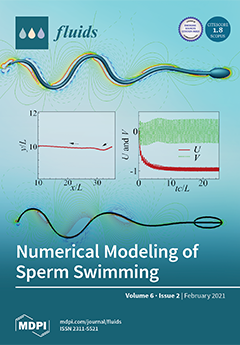The dynamic behaviours of a filament in a viscoelastic uniform flow were investigated by an immersed boundary-lattice Boltzmann method. The effects of the Reynolds numbers (
, ranging from 10 to 200) and the Weissenberg number (
, ranging
[...] Read more.
The dynamic behaviours of a filament in a viscoelastic uniform flow were investigated by an immersed boundary-lattice Boltzmann method. The effects of the Reynolds numbers (
, ranging from 10 to 200) and the Weissenberg number (
, ranging from 0 to 1.2) on the filament flapping motion and the drag and lift coefficients on the filament were studied. It was found that a higher inertial effect (larger
) promotes the flapping motion of the filament. In addition, the major effect of the viscoelasticity of the Giesekus fluid is to decrease the critical Reynolds number for the flapping motion of the filament and to promote the flapping motion. The drag coefficient on the filament in a Giesekus uniform flow decreases with the increase of
at low
(
), and experiences oscillations with similar amplitudes at all
at a sufficiently high
(
). In contrast, the viscoelasticity of the FENE-CR fluid increases the critical Reynolds number at lower
(
), and shows little influence on the critical Reynolds number at higher
(
). In addition, the viscoelasticity of the FENE-CR fluid hinders the flapping motion of the filament, and increases the drag coefficient on the filament at low
(
).
Full article





